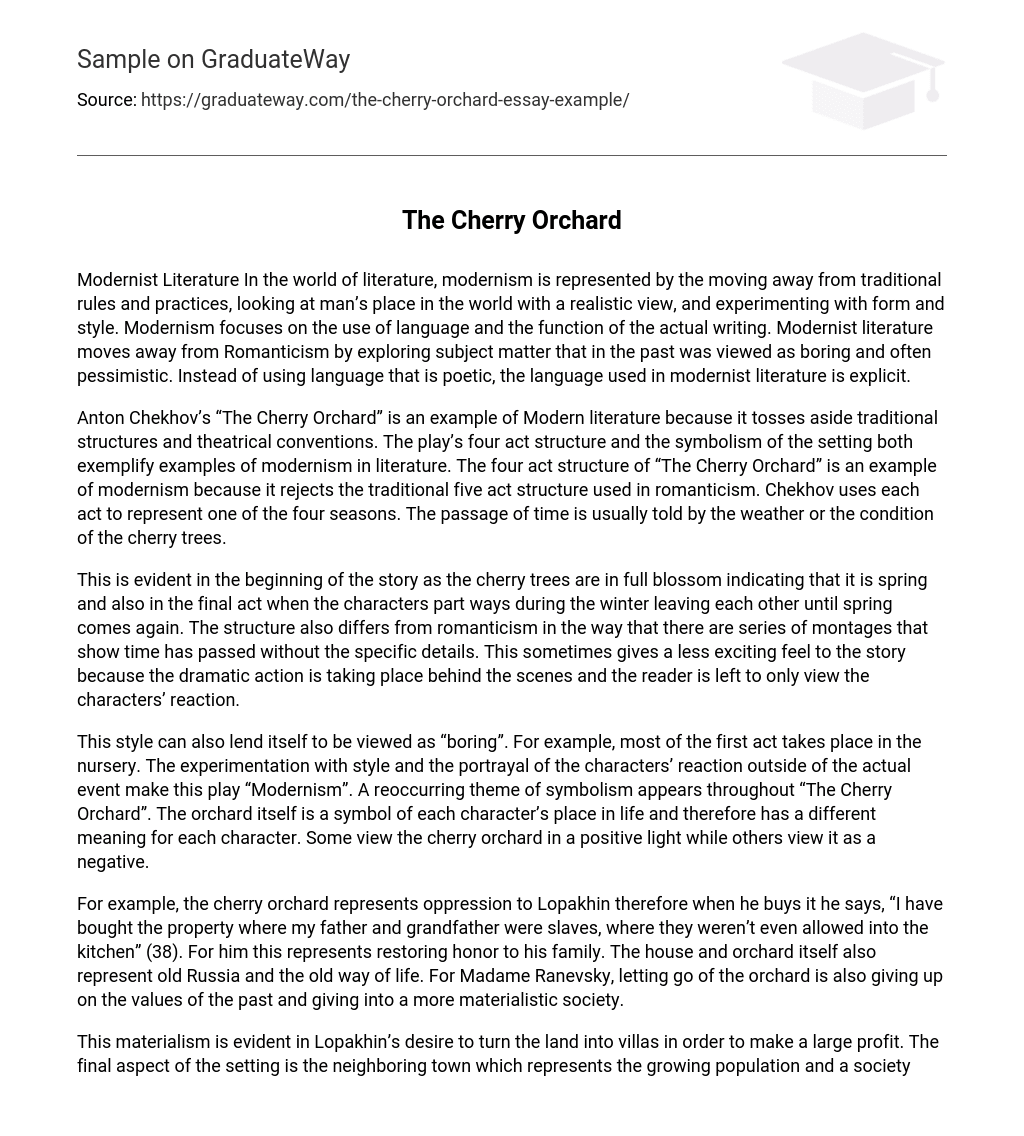Modernist Literature In the world of literature, modernism is represented by the moving away from traditional rules and practices, looking at man’s place in the world with a realistic view, and experimenting with form and style. Modernism focuses on the use of language and the function of the actual writing. Modernist literature moves away from Romanticism by exploring subject matter that in the past was viewed as boring and often pessimistic. Instead of using language that is poetic, the language used in modernist literature is explicit.
Anton Chekhov’s “The Cherry Orchard” is an example of Modern literature because it tosses aside traditional structures and theatrical conventions. The play’s four act structure and the symbolism of the setting both exemplify examples of modernism in literature. The four act structure of “The Cherry Orchard” is an example of modernism because it rejects the traditional five act structure used in romanticism. Chekhov uses each act to represent one of the four seasons. The passage of time is usually told by the weather or the condition of the cherry trees.
This is evident in the beginning of the story as the cherry trees are in full blossom indicating that it is spring and also in the final act when the characters part ways during the winter leaving each other until spring comes again. The structure also differs from romanticism in the way that there are series of montages that show time has passed without the specific details. This sometimes gives a less exciting feel to the story because the dramatic action is taking place behind the scenes and the reader is left to only view the characters’ reaction.
This style can also lend itself to be viewed as “boring”. For example, most of the first act takes place in the nursery. The experimentation with style and the portrayal of the characters’ reaction outside of the actual event make this play “Modernism”. A reoccurring theme of symbolism appears throughout “The Cherry Orchard”. The orchard itself is a symbol of each character’s place in life and therefore has a different meaning for each character. Some view the cherry orchard in a positive light while others view it as a negative.
For example, the cherry orchard represents oppression to Lopakhin therefore when he buys it he says, “I have bought the property where my father and grandfather were slaves, where they weren’t even allowed into the kitchen” (38). For him this represents restoring honor to his family. The house and orchard itself also represent old Russia and the old way of life. For Madame Ranevsky, letting go of the orchard is also giving up on the values of the past and giving into a more materialistic society.
This materialism is evident in Lopakhin’s desire to turn the land into villas in order to make a large profit. The final aspect of the setting is the neighboring town which represents the growing population and a society in transition. Society at that time was moving towards industrialization and the town represents this aspect of man’s place in the world during this period of time. As the characters depart from the orchard, they return to their modern lives. The use of symbolism with the setting is an example of the modernist approach to representing a realistic view of the world.
Anton Chekhov’s play, “The Cherry Orchard”, is an example of Modernist literature because of its four act structure and the use of symbolism in the setting. The configuration of the play differs from Romanticism’s five act structure, and uses a different approach to writing styles. A Modernist style is also used in this play by applying symbolism with the setting and showing a more reasonable way of life. The Modernism way of writing, while sometimes considered “dull”, is more connected with people than the ideal ways of Romanticism.





